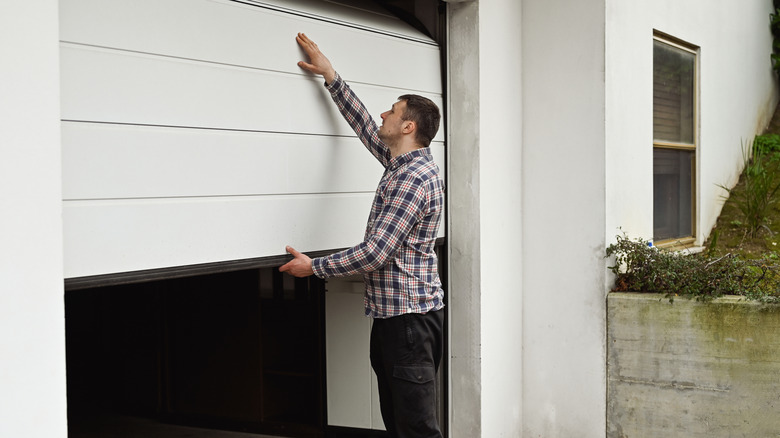How To Know If Your Garage Door Is Off-Track (And How To Fix It)
It's human nature to take things for granted until they stop working. The coffee maker sputters one morning, and the whole morning routine collapses in the blink of an eye. The Wi-Fi drops, and the world feels like it's come to an end. But one workhorse that tops them all is your garage door. It rarely asks for attention, and does the job rain or shine. Until one day, it doesn't. You press the button, and instead of that effortless glide, the door jerks. That's your cue. When your garage won't open properly, the door makes strange noises, or leaves awkward gaps between the track and rollers, it's off-track. The bright side is that, most of the time, it's just a matter of realigning the tracks. Other times, you may need to swap out a few tired rollers.
Garage doors don't go off track for no reason. Just like people, they show signs of neglect long before they fall apart. Maybe someone bumped it with the car, or perhaps it was installed a bit too fast and loose. It could also be that those rollers have been wearing down for years without you even knowing. It's the small stuff that builds up until the whole system slips out of sync. Remember, a garage door that's cared for rarely derails. If yours has, it's likely paying the price for some overlooked maintenance.
Check for these signs to detect an off-track garage door
A healthy garage door should move as smoothly as a yawn on a Sunday morning. So, when it jams mid-way, that's your first red flag. It typically happens because something's thrown off its motion. Maybe one side of your track is slightly misaligned, or a roller's slipped out of place. This forces the whole system to fight against itself.
Further, if your garage door tracks look warped or bent, that's another big clue. Tracks are meant to guide the door. But when they're warped, they tend to throw the rollers off balance, which causes the door to tilt. Speaking of rollers, once they start deteriorating, that's usually where a trouble-free ride ends. You may, for example, notice them slipping out of their grooves, which forces the door off its path.
And finally, there are loud screeching or grinding noises your garage door makes. That harsh metal-on-metal sound usually means friction somewhere it shouldn't be. Often, it traces back to loose tracks that started wobbling with every movement.
Repair your off-track garage door
Before getting started, gather a few essentials, including a wrench, a screwdriver, a level, a rubber mallet, and safety gloves. Once you're ready, release that red emergency cord hanging from the opener. Cutting the power is important so your door doesn't suddenly jolt to life while you're hands-on.
Next, lift the door by hand. Look closely along both tracks and find the wheel that's escaped its groove. Clear out any dirt that might be crowding the area. A clean pathway always brings the underlying issue to light. If the track looks bent, use a rubber mallet to guide it back into shape. Make sure you also tighten any loose bolts while you're at it, because even a single shaky bracket can cause a problem.
Then, take a screwdriver and open the edge of the track. Coax the roller back into place slowly. Once the roller slides in, close the track and test the movement. If all feels right, turn the opener back on. And if the rollers look worn out, it's one of the clear signs that your garage door rollers need to be replaced. A fresh set keeps everything rolling in harmony again.


